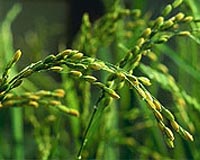 |
Manila, Philippines (SPX) Jul 24, 2009 Rice is the world's most important food crop. Understanding its valuable genetic diversity and using it to breed new rice varieties will provide the foundation for improving rice production into the future and to secure global food supplies. Recently published in the Proceedings of the National Academy of Science, an international research team of researchers scrutinized the genomes of twenty different types of genetically diverse rice used in international breeding with a wide range of different characteristics. "We searched for snippets of DNA that distinguish each type of rice," says Dr. Ken McNally from the International Rice Research Institute (IRRI). "If the rice types share a favourable trait, like drought tolerance, high yield, or even desirable cooking quality characteristics, they are likely to also share the same DNA variation responsible for that trait." Rice contains tens of thousands of genes, so finding a successful way to hunt through them all is a major breakthrough. IRRI maintains the International Rice Gene Bank containing over 109,000 types of rice, yet relatively few have been used in breeding programs. Director General of IRRI, Dr. Robert Zeigler, says "If breeders know more about the genetic makeup of rice, they can use it more effectively. As we face more erratic changes in climate, we will increasingly rely on using the untapped diversity of rice to develop new and improved rice varieties." This study represents a significant international collaboration across the globe, including researchers from countries in Asia, North America, and Europe. The work attracted scientists interested in both basic and applied science, from evolution, crop domestication, to practical breeding. Dr. Jan Leach, University Distinguished Professor at Colorado State University, a co-author on the study, indicates that "the comprehensive SNP information is enabling the exploration of rice diversity not only for understanding how genes function in a growing and developing plant, but also for improving important rice traits related to disease resistance, drought tolerance, increased productivity, and human health benefits." Detlef Weigel, Director of the Max Planck Institute for Molecular Biology and collaborator on the project, agrees: "This work sets the stage for the next phase of unlocking the treasure trove of genetic diversity available at IRRI and other centres for rice breeding." This research was published in the Proceedings of the National Academy of Science (PNAS). It was done in collaboration with Colorado State University, Michigan State University, Perlegen Sciences, Inc., McGill University, the Max Planck Institute for Developmental Biology, the Friedrich Miescher Laboratory of the Max Planck Society, and Cornell University with support from a consortium of institutions and donors including the Generation Challenge Program, and the United States Department of Agriculture. Share This Article With Planet Earth
Related Links International Rice Research Institute Farming Today - Suppliers and Technology
 Genetically modified rice crucial in drought battle: report
Genetically modified rice crucial in drought battle: reportManila (AFP) July 22, 2009 Genetic modification may be the only viable way to produce sufficient quantities of rice in the future as drought, climate change and dwindling acreage impact yields, experts said in a new report. Rice is the staple food of around three billion people and the main challenge facing producers is how to raise yields of the water-dependent crop as 70 percent of the world's food-growing areas tur ... read more |
|
| The content herein, unless otherwise known to be public domain, are Copyright 1995-2009 - SpaceDaily. AFP and UPI Wire Stories are copyright Agence France-Presse and United Press International. ESA Portal Reports are copyright European Space Agency. All NASA sourced material is public domain. Additional copyrights may apply in whole or part to other bona fide parties. Advertising does not imply endorsement,agreement or approval of any opinions, statements or information provided by SpaceDaily on any Web page published or hosted by SpaceDaily. Privacy Statement |